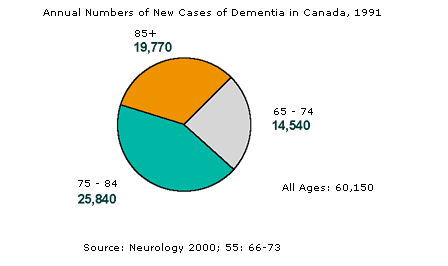
The CSHA objectives were divided
into four categories.
1.
Core objectives addressed the prevalence, incidence and risk
factors for dementia, and the impact of dementia on family
caregivers.
2. Secondary objectives
covered other health topics (such as disability, frailty or
healthy aging) that could readily be addressed in the context
of the study.
3. In addition, participating
investigators were encouraged to add supplementary “add-on”
studies of personal interest to them, and for which they could
obtain separate funding.
4. Finally, it was
anticipated that the CSHA results would generate “spin-off”
studies that could be undertaken by the same team members
under separate funding arrangements.
The objectives for the 1991 CSHA-1
study were:
1. To estimate the prevalence
of dementia among elderly Canadians;
2. To identify risk factors
for Alzheimer’s disease and for vascular dementia;
3. To describe patterns of
caring for patients with dementia in Canada and to assess
the burden that caring places on the caregivers;
4. To establish a database
for subsequent follow-up studies.
At CSHA-1 about a dozen add-on studies
were undertaken, while the spin-off studies included the development
of further diagnostic criteria for cognitive impairment, which
influenced the subsequent development of CSHA-2, the second
wave of the study.
CSHA-2 (1996)
The core objectives for CSHA-2 focused
on the incidence and risk factors for dementia, but many secondary
objectives were included, several building on work undertaken
as add-on components of CSHA-1:
Cognition:
1. To estimate the incidence of dementia (all forms
combined; Alzheimer’s disease, and vascular dementia);

2. To undertake cohort analyses
of risk factors for Alzheimer’s disease and for vascular
dementia;
3. To examine patterns of
coexisting chronic disease in the demented and non-demented
populations;
4. To describe the clinical course of dementia, including
predictors of decline, institutional admission and mortality
rates by sex, age and region.
5. To trace and classify
the early stages of cognitive loss, identifying characteristics
that distinguish those who progress to dementia, and describing
patterns of normal cognitive aging.
Health, Disability and Frailty:
1. To determine what proportion of the elderly age
“successfully”, to describe their characteristics
and to identify predictors of successful aging;
2. To estimate the incidence
and predictors of dependency in activities of daily living;
3. To review patterns and
predictors of frailty; to identify the outcomes of frailty
in terms of risk of subsequent illness, cognitive decline,
institutional admission and mortality;
4. To examine the predictors
of admission to institutional care.
Caregiving:
1. To quantify changes over time in the health of caregivers
of people with dementia compared to caregivers of cognitively
normal people;
2. To describe changes over
time in the patterns of service utilization and support received
by caregivers.

CSHA-3 (2001)
CSHA-3 completed our work on the
early stages of cognitive decline and was intended to set
the groundwork for intervention studies.
Cognition:
1. To estimate the prevalence and risk of progression
from various categories of cognitive impairment or loss to
dementia, based on the classification developed at CSHA-2;
2. To identify characteristics
and / or test scores that prospectively distinguish those
who develop dementia. From this, to develop algorithms to
identify people at risk of decline;
3. To model the potential
population impact of interventions for early cognitive impairment,
covering impacts on longevity, costs to the health care system,
and burden on caregivers.
Health, Disability and Frailty:
1. To describe the patterns of functional decline,
frailty, institutional admission and mortality associated
with various categories of cognitive change;
2. To estimate the 5-year
outcomes of frailty, as defined at CSHA-2;
3. To provide outcome data
on those who were apparently aging successfully at CSHA-1
and 2, and from this to refine our analysis of predictors
of successful aging.
Caregiving:
1. To describe the needs for care of people with and
without cognitive problems, to examine the care they receive
in Canada, and to give a summary indication of the quality
of life of their caregivers;
2. To compare patterns of
community support service use for people with normal cognition,
with early cognitive impairment, and with dementia;
3. To estimate the
marginal cost of support and health services utilization for
caregivers of persons with cognitive impairment.
|



